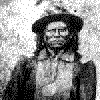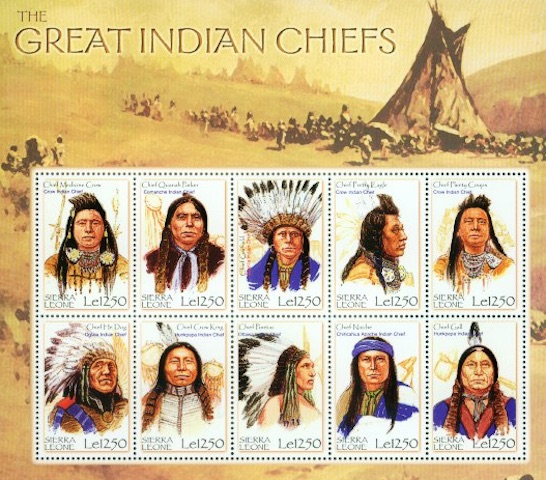To view this page in another language, please click here:
Great
Chiefs & Leaders
Po'pa
A True American Hero
Popé (Tewa)
Famous
chiefs and leaders
List
of
Native American leaders
Native
American
Indian Chiefs
Native
Americans
Image Gallery

American Horse (Sioux)
Black Elk (Lakota)
Big Bear (Cree)
Bigfoot (Lakota)
Chief
Black
Hoof
Abel Bosum (Cree)
Joseph Brant (Mohawk)
Cochise (Apache)
Choncape
Chou-man-i-case
Corn Planter
Crazy Horse/Tashunkewitko
(Lakota)
Dan George
Dull Knife (Cheyenne)
Eagle og Delight
Frank Fools Crow
Gall (Hunkpapa Sioux)
Geronimo/Goyathlay (Apache)
He-Dog (Oglala)
Little Wolf (Lakota)
Hole-in-the-Day (Ojibway)
John Ross (Cherokee)
Joseph (Nez Perce)
Keokuk
Little Crow (Kaposia Sioux)
Little Raven (Hósa, 'Young
Crow')
(Arapaho)
Little Turtle (Miami)
Little Wolf (Cheyenne)
Low-Dog (Lakota)
Joseph (Nez Perce)
Mougo
Nawat
['Left-hand']
(Arapaho)
Ohiyesa/Dr. Charles Alexander
Eastman
(Santee Sioux)
Oihduze
Osceola (Seminole)
Pontiac (Ottawa) Potalesharo
Quanah Parker (Comanche)
Rain-in-the-Face (Sioux)
Red Cloud (Lakota)
Red Jacket (Seneca)
Roman Nose (Cheyenne)
Santana
(Kiowa)
Seattle (Suquamish)
Sequoya (Cherokee)
Sitting Bull (Hunkpapa Sioux)
Spotted Tail (Brule Sioux)
Standing Bear (Lakota)
Tamahay (Sioux)
Tecumseh (Shawnee)
Two Strike/Tashunkekokipapi
(Sioux)
Washakie (Shoshoni)
White
Plume (Kaw)
Wicked Chief
Wolf Robe (Cheyenne)
Wovoka (Paiute)
Cheyenne
Dull Knife, Cheyenne
Chief Roman Nose, Cheyenne
Little Wolf, Cheyenne
Two Moons, Cheyenne
Wolf Robe, Cheyenne
Lean Bear, Cheyenne
Wooden Leg, Cheyenne
White Buffalo, Cheyenne
Black Kettle, Cheyenne
Sharp Nose, Arapaho
Medicine Man, Arapaho
Black Man, Arapaho
Chief Black Bear, Arapaho
Black Coal, Arapaho
Cut Nose, Arapaho,
Little Raven, Arapaho
Cheyenne
&
Arapaho Chiefs
Top
Ten
Most Famous
American
Indians
In History
1) Hiawatha
Hiawatha is perhaps the most famous Native American in
history. The famous author Henry Wadsworth Longfellow
wrote a story that was based loosely on Hiawatha's life,
which was entitled ‘The Song of Hiawatha’. Little
historical data remains of Hiawatha's life, although it is
widely known that he was a peacemaker, a leader, and a
spiritual guide. Skilled in putting positive political
plans into action, Hiawatha helped persuade five Native
American tribes who shared a similar language, namely the
Iroquois, the Onondagas, the Senecas, the Cayugas, the
Oneidas, and the Mohawks to
come together to form the Five Nations of the Iroquois
confederacy.
2) Black Hawk
Black Hawk was not a traditional Native American tribe
chief. Although he inherited a medicine bundle, he became
more widely known as a War Chief. Black Hawk's real name
was Makataimeshekiakiak. This means “Be a large black
hawk” in his native tongue of Sauk. His name was shortened
by the English, with whom he engaged in a battle known as
the War of 1812. He was the fiercest and most powerful
opponent of the English, as he eventually led a band of
Sauk and Fox to fight settlers in Wisconsin and Illinois.
He died in Iowa, but his legend remains alive to this day.
3) Sitting Bull
Named Slon-he, which literally translates to slow, Sitting
Bull was a holy man and a Hunkpapa Lakota Sioux medicine
man. He was famous for his premonition of winning against
Lt. Col. George Custer at the Battle of Little Bighorn,
which came true. He went to Canada for a short while after
the battle, and when he returned to the United States, he
joined Buffalo Bill's Wildwest Show as a performer. He was
killed at the Standing Rock Indian Reservation by the
police while they were attempting to arrest him and stop
him from supporting the Ghost Dance movement.
4) Pocahontas
Pocahontas, whose real name is Matoaka, is perhaps the
most popular female Native American. Pocahontas was
actually a childhood nickname given to her because of her
frolicsome nature. She became known around the world after
Disney's portrayal of her life. The story was actually
inaccurate, although it is true that she married an
Englishman named John Rolfe. Her father, Wahunsunacock,
who was also known as Chief or Emperor Powhatan, presided
over an area that is now known as Virginia. During her
final days, she adopted an English life and the name
Rebecca Rolfe, abandoning her Native American heritage.
5) Crazy Horse
Crazy Horse is a Lakota who had the name Thasuka Witko,
which literally means “His-Horse-is-Crazy.” Born with the
Native American name of Cha-O-Ha, meaning “In the
Wilderness”, Crazy Horse was also called Curly because of
his hair. In 1876, Crazy Horse led a group of Lakotans and
Cheyennes in the Great Sioux War. This was a surprise
attack against an English troop led by General George
Crook, with the support of 300 Crow and Shoshone warriors.
The battle prevented General Crook from teaming up with
Colonel Custer, which led to Custer's defeat at the Battle
of Little Bighorn. Throughout his life, Crazy Horse
actively opposed the US Government in its negative
decisions on various Indian affairs.
6) Red Cloud
Red Cloud was one the most capable warriors from the Sioux
or Oglala Lakota tribe. Born Makhpiya Luta, Red Cloud was
the fiercest Sioux tribesman ever faced by the US
military. He led his people in what is known in history as
Red Cloud’s War, the most successful war ever waged by a
Native American against the US military. The war was a
battle for the rights of the Sioux to an area called the
Powder River Country in Southern Montana and Northern
Wyoming. He died at the ripe age of 87 at the Pine Ridge
Reservation, where his remains are buried.
7) Geronimo
A prominent Native American leader, Geronimo led the
Chiricahua Apache to fight against the encroachment of the
US government on the tribe's lands. Geronimo, whose name
literally means “one who yawns” in Chiricahua, fought for
his tribesmen for 25 years. He was a great military and
spiritual leader, although he was not a tribal chief. He
led the last great Native American uprising, after which
he led his people to a reservation.
He married six wives, following the Apache tradition.
8) Pontiac
Known as Obwandiyag in Ottawa, Chief Pontiac defended the
Great Lakes Region from the invasion and occupation of the
British Troops. Pontiac also led a revolt that took Fort
Detroit at what became known as The Battle of Bloody Run.
Despite being a prominent figure, many historians are
still unsure as to whether or not Pontiac was truly a
leader rather than a mere follower. In 1769, Pontiac was
assassinated by a member of the Peoria tribe in Illinois.
9) Sacajawea
Sacajawea, whose name is alternatively spelled Sacagawea
or Sakakawea, is another well-known Native American woman.
She was born to the Shoshone tribe known as the Agaidika
or “Salmon Eater”. Sacajawea was only 12 when she and
other young girls were kidnapped by a group of Hidatsa
men, after which they were taken to a Hidatsa village. She
married a French trapper named Toussaint Charbonneau, with
whom she has a son named Jean Baptiste. She was known for
accompanying Meriwether Lewis and William Clark in their
Corps of Discovery of the western part of the United
States in 1806. Sacajawea's face now appears on the dollar
coin.
10) Will Rogers
A Cherokee-Cowboy, Will Rogers was a popular Native
American actor, philanthropist, social commentator,
Vaudevillian, comedian, and presidential candidate. He was
born William Peen Adair Rogers to a well respected and
relatively wealthy family, and was often hailed as
Oklahoma's favorite son. He knew how to ride horses so
well that he ended up in the Guinness Book of World
Records. His record was for simultaneously throwing three
ropes at a horse—one around the horse's rider, one around
the neck, and one around all four legs. He appeared in 71
films, and wrote more than 4,000 columns for
nationally-syndicated newspapers. In 1935, he died in a
plane crash in Barrow, Alaska.
![]() Return to Indigenous Peoples' Literature
Return to Indigenous Peoples' Literature
Compiled by: Glenn
Welker
ghwelker@gmx.com
This site has been accessed 10,000,000 times since February 8, 1996.
